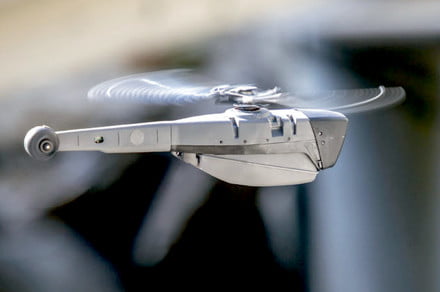[youtube https://www.youtube.com/watch?v=rm_xMuo2Ong]
Advancing armies already deploy a range of techniques for reconnaissance missions, with more recent technology such as remotely controlled copters enabling close-up exploration of a battle zone. Such systems play a vital role in enhancing the safety of soldiers heading into potential danger, as well as those tasked with gathering the important data.
One reconnaissance device that’s been gaining increasing attention is FLIR Systems’ pocket-sized Black Hornet drone.
Several years in development, the remotely controlled, camera-equipped copter is heading to Afghanistan this month with the 82nd Airborne Division, marking the debut deployment of the tiny drone in the war-torn country, Stars and Stripes reported.
The U.S. Army started testing the drone three years ago, and since then FLIR Systems has gone on to ink additional deals with not only the U.S. military but also the British and French armies. In fact, the U.K. government recently gave a clear demonstration of its belief in the technology when it placed an order for 30 more Black Hornets.
The cost of that particular purchase is believed to be 1.4 million British pounds (nearly U.S. $1.8 million), working out to about $60,000 per drone. That’s certainly a hefty chunk of cash, but the flying machine offers a number of major advantages over cheaper, more conventional drone technology currently on the market.
First, at just 16.8cm in length, the twin-rotor Black Hornet is tiny, making it easy to transport, and, more importantly, hard to spot when it’s in the air. It’s also pretty much silent, increasing its stealthiness as it goes about exploring enemy territory. During flights lasting up to 25 minutes, and with the machine traveling at up to 6 meters (20 feet) per second, the 1.2-ounce drone can stream live video and HD still images through an encrypted data link connected to an operator located up to 1.2 miles away.
While the Black Hornet can be carried as a single unit by one soldier, FLIR Systems also offers a compact launch unit, which can be attached to a military vehicle and used to deploy up to four of the drones at a time.
The most recent design of the Black Hornet includes a night-vision camera, while another version allows a variety of components to be added according to the specifics of the mission.
Discussing the drone with Digital Trends last year, Ole Aguirre, an executive at Oregon-based FLIR Systems, talked about how the Black Hornet can be particularly useful in urban environments for scouting rooftops, streets, and buildings for snipers or assault groups, enabling better-informed decisions during crucial moments as soldiers seek to take up new positions.
The Black Hornet’s imminent deployment to Afghanistan is the latest indication of how drone technology is playing an increasingly important role on the battlefield.
In May 2019, for example, French drone-maker Parrot revealed it had been selected by the U.S. Department of Defense along with six other companies to develop small, short-range aircraft for use by soldiers on the battlefield, the others being Skydio, Altavian, Teal Drones, Vantage Robotics, and Lumenier.
Parrot is expected to create a more advanced version of its Anafi quadcopter, which currently offers 4K video and 21-megapixel stills, a 25-minute flight time, and a range of around 2 miles.
Editors’ Recommendations
- Parrot to build small surveillance drones for U.S. soldiers on the battlefield
- Army uses modified Microsoft HoloLens 2 for ‘real-life game of Call of Duty’
- DroneBullet is a kamikaze drone missile that knocks enemy UAVs out of the sky
- U.K. launches $2.5M contest for tech to counter threats from rogue drones
- Ghost Recon Breakpoint wants to kill you, one way or another

